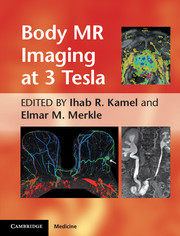Book contents
- Frontmatter
- Contents
- Contributors
- Foreword
- Preface
- Chapter 1 Body MR imaging at 3T: basic considerations about artifacts and safety
- Chapter 2 Novel acquisition techniques that are facilitated by 3T
- Chapter 3 Breast MR imaging
- Chapter 4 Cardiac MR imaging
- Chapter 5 Abdominal and pelvic MR angiography
- Chapter 6 Liver MR imaging at 3T: challenges and opportunities
- Chapter 7 MR imaging of the pancreas
- Chapter 8 MR imaging of the adrenal glands
- Chapter 9 Magnetic resonance cholangiopancreatography
- Chapter 10 MR imaging of small and large bowel
- Chapter 11 MR imaging of the rectum, 3T vs. 1.5T
- Chapter 12 Imaging of the kidneys and MR urography at 3T
- Chapter 13 MR imaging and MR-guided biopsy of the prostate at 3T
- Chapter 14 Female pelvic imaging at 3T
- Index
- Plate section
- References
Chapter 9 - Magnetic resonance cholangiopancreatography
Published online by Cambridge University Press: 05 August 2011
- Frontmatter
- Contents
- Contributors
- Foreword
- Preface
- Chapter 1 Body MR imaging at 3T: basic considerations about artifacts and safety
- Chapter 2 Novel acquisition techniques that are facilitated by 3T
- Chapter 3 Breast MR imaging
- Chapter 4 Cardiac MR imaging
- Chapter 5 Abdominal and pelvic MR angiography
- Chapter 6 Liver MR imaging at 3T: challenges and opportunities
- Chapter 7 MR imaging of the pancreas
- Chapter 8 MR imaging of the adrenal glands
- Chapter 9 Magnetic resonance cholangiopancreatography
- Chapter 10 MR imaging of small and large bowel
- Chapter 11 MR imaging of the rectum, 3T vs. 1.5T
- Chapter 12 Imaging of the kidneys and MR urography at 3T
- Chapter 13 MR imaging and MR-guided biopsy of the prostate at 3T
- Chapter 14 Female pelvic imaging at 3T
- Index
- Plate section
- References
Summary
Introduction
Magnetic resonance cholangiopancreatography (MRCP), in use since the 1990s [1], is an accepted noninvasive imaging technique for the diagnosis of pancreaticobiliary diseases. MRCP images are created with the acquisition of heavily T2-weighted images, and can demonstrate the fluid-filled lumen of the biliary tree and the pancreatic duct with high signal intensity. It is comparable to endoscopic retrograde cholangiopancreatography (ERCP) in the diagnosis of biliary-pancreas pathologic conditions [2–5]. The advantages of MRCP over other imaging techniques include (1) the examination is noninvasive and requires no anesthesia; (2) the examination is not operator dependent, and high-quality images can be obtained consistently; (3) no administration of intraductal or intravenous contrast agent is necessary; (4) no ionizing radiation is used; (5) visualization of ducts proximal to an obstruction is superior to that achieved by ERCP; (6) MRCP can be successfully performed in the presence of biliary–enteric anastomoses; and (7) combination with conventional MR sequences is possible and helpful for the evaluation of duct wall and extraductal disease [6]. For many years, ERCP has been considered the standard of reference for imaging the biliary tract and pancreatic duct owing to its higher spatial resolution and potential for image-guided therapy [7]. However, it has a reported complications rate of up to 5% including duodenal perforation, pancreatitis, bleeding and sepsis [8]. For all of these reasons, MRCP has replaced diagnostic ERCP in the last few years, unless an intervention or tissue sampling is required [9].
- Type
- Chapter
- Information
- Body MR Imaging at 3 Tesla , pp. 123 - 133Publisher: Cambridge University PressPrint publication year: 2011

